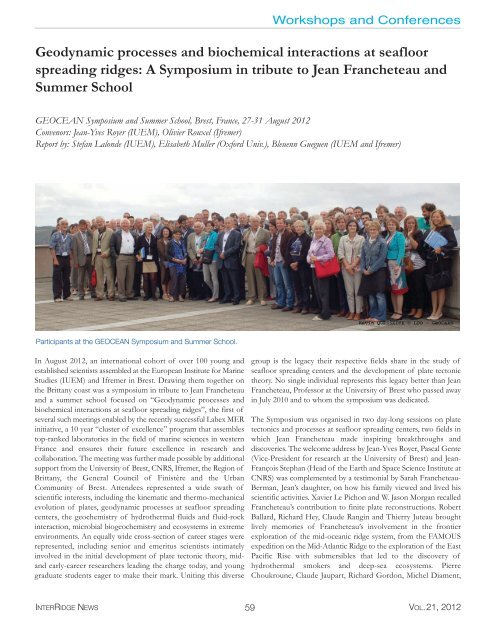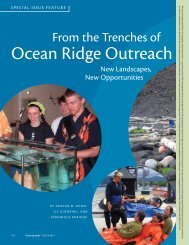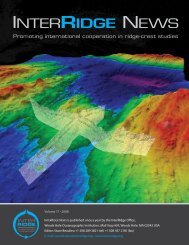Full version, low resolution, 7.5MB - InterRidge
Full version, low resolution, 7.5MB - InterRidge
Full version, low resolution, 7.5MB - InterRidge
Create successful ePaper yourself
Turn your PDF publications into a flip-book with our unique Google optimized e-Paper software.
Workshops and Conferences<br />
Geodynamic processes and biochemical interactions at seafloor<br />
spreading ridges: A Symposium in tribute to Jean Francheteau and<br />
Summer School<br />
GEOCEAN Symposium and Summer School, Brest, France, 27-31 August 2012<br />
Convenors: Jean-Yves Royer (IUEM), Olivier Rouxel (Ifremer)<br />
Report by: Stefan Lalonde (IUEM), Elisabeth Muller (Oxford Univ.), Bleuenn Gueguen (IUEM and Ifremer)<br />
Participants at the GEOCEAN Symposium and Summer School.<br />
In August 2012, an international cohort of over 100 young and<br />
established scientists assembled at the European Institute for Marine<br />
Studies (IUEM) and Ifremer in Brest. Drawing them together on<br />
the Brittany coast was a symposium in tribute to Jean Francheteau<br />
and a summer school focused on “Geodynamic processes and<br />
biochemical interactions at seafloor spreading ridges”, the first of<br />
several such meetings enabled by the recently successful Labex MER<br />
initiative, a 10 year “cluster of excellence” program that assembles<br />
top-ranked laboratories in the field of marine sciences in western<br />
France and ensures their future excellence in research and<br />
collaboration. The meeting was further made possible by additional<br />
support from the University of Brest, CNRS, Ifremer, the Region of<br />
Brittany, the General Council of Finistère and the Urban<br />
Community of Brest. Attendees represented a wide swath of<br />
scientific interests, including the kinematic and thermo-mechanical<br />
evolution of plates, geodynamic processes at seafloor spreading<br />
centers, the geochemistry of hydrothermal fluids and fluid-rock<br />
interaction, microbial biogeochemistry and ecosystems in extreme<br />
environments. An equally wide cross-section of career stages were<br />
represented, including senior and emeritus scientists intimately<br />
involved in the initial development of plate tectonic theory, midand<br />
early-career researchers leading the charge today, and young<br />
graduate students eager to make their mark. Uniting this diverse<br />
group is the legacy their respective fields share in the study of<br />
seafloor spreading centers and the development of plate tectonic<br />
theory. No single individual represents this legacy better than Jean<br />
Francheteau, Professor at the University of Brest who passed away<br />
in July 2010 and to whom the symposium was dedicated.<br />
The Symposium was organised in two day-long sessions on plate<br />
tectonics and processes at seafloor spreading centers, two fields in<br />
which Jean Francheteau made inspiring breakthroughs and<br />
discoveries. The welcome address by Jean-Yves Royer, Pascal Gente<br />
(Vice-President for research at the University of Brest) and Jean-<br />
François Stephan (Head of the Earth and Space Science Institute at<br />
CNRS) was complemented by a testimonial by Sarah Francheteau-<br />
Berman, Jean’s daughter, on how his family viewed and lived his<br />
scientific activities. Xavier Le Pichon and W. Jason Morgan recalled<br />
Francheteau’s contribution to finite plate reconstructions. Robert<br />
Ballard, Richard Hey, Claude Rangin and Thierry Juteau brought<br />
lively memories of Francheteau’s involvement in the frontier<br />
exploration of the mid-oceanic ridge system, from the FAMOUS<br />
expedition on the Mid-Atlantic Ridge to the exploration of the East<br />
Pacific Rise with submersibles that led to the discovery of<br />
hydrothermal smokers and deep-sea ecosystems. Pierre<br />
Choukroune, Claude Jaupart, Richard Gordon, Michel Diament,<br />
INTERRIDGE NEWS 59 VOL.21, 2012
















